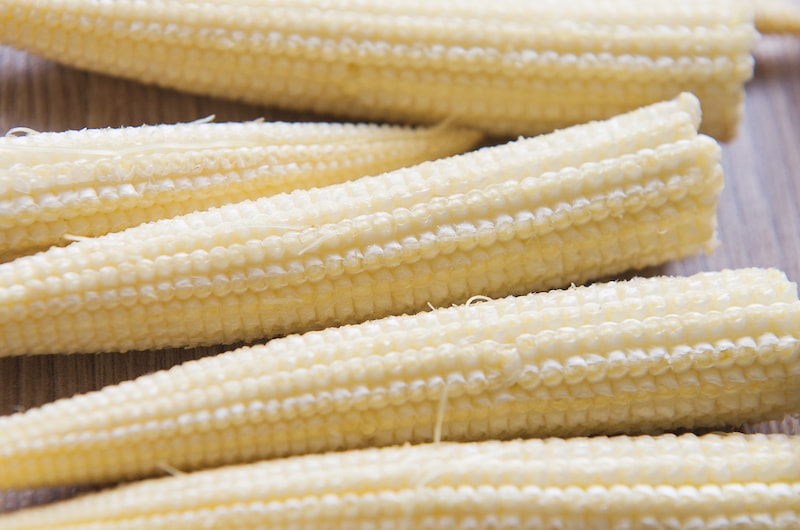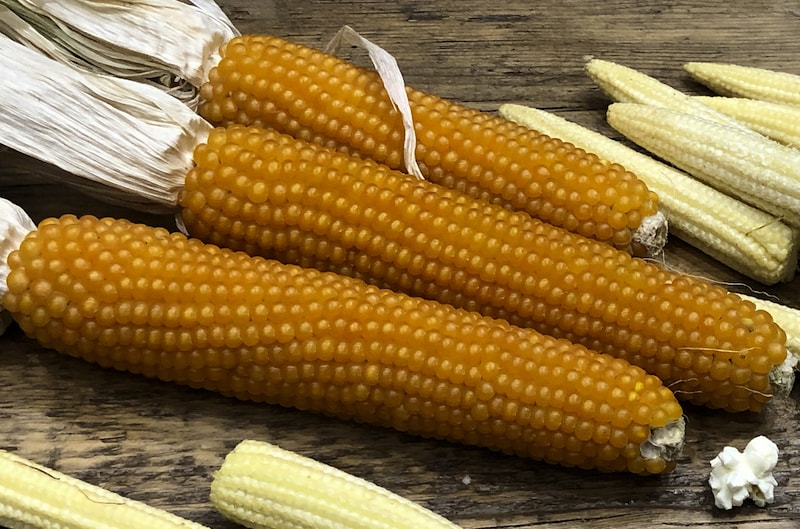Sweet corn is surprisingly easy to grow in the UK thanks to new varieties that thrive in our shorter summers. To help you enjoy a successful harvest, we’ve asked our favourite gardening bloggers to share their top tips. From sowing sweet corn seeds to planting out and pollinating, follow their expert advice and you’ll soon be eating delicious cobs fresh from your garden!
Browse our full range of sweet corn seeds for new and traditional varieties.
Contents:
- Best advice on sowing sweet corn seeds
- Best advice on planting out sweet corn
- Best advice on the ‘Three Sisters’ planting method
- Best advice on pollinating and harvesting sweet corn
Best advice on sowing sweet corn seeds

Image: Sweetcorn ‘Pot of Gold’ F1 seeds from Suttons/©Rob Smith’s Allotment
For guaranteed success when growing sweet corn from seed, try John Harrison’s method, which “never fails to produce a good crop”. He chits his seeds between layers of damp kitchen paper in a warm and dark place like an airing cupboard. Taking just a few days to sprout, they can then be planted in multipurpose compost. Read the full article over at Allotment & Gardens for more great tips including how to encourage strong root growth.
If you’re growing sweet corn in a cooler region, Charles Dowding says it’s a good idea to get your seedlings started in the warmth of a greenhouse. Watch his YouTube short to see his tried and tested method for sowing sweet corn seeds in module trays. Showing the process from start to finish, he revisits his greenhouse a week later so you can see how quickly they sprout!
Over at @cutflowerallotment, allotment gardener Leoni’s sweet corn is ready to plant out. She raised her sweet corn seedlings in toilet roll tubes, which allowed the roots to grow through without restriction. Scroll through her photos to see how strong the young plants look! Leoni plants squash alongside her sweet corn to shade their roots. Follow her on Insta for lots more practical growing tips and advice.
While starting off sweet corn seedlings in toilet rolls is an affordable and eco-friendly method, Patient Gardener Daniel Berry prefers to use large root trainers. These have all the same benefits as cardboard tubes, but “they hinge open from the side so you can get your sweet corn plant out without doing any damage to the roots.” Learn the other reasons he prefers this approach in the full article.
Best advice on planting out sweet corn

Image: Sweet Corn F1 ‘Minipop’ seeds from Suttons
YouTube gardener Mark is a big fan of freshly-picked, homegrown sweet corn for its incomparable flavour. His top tip for great results is to “work some fish, blood and bone into your bed” approximately three weeks before you plant out your young sweet corn. Mark particularly recommends growing sweet corn in raised beds because they retain water better. Watch his helpful video guide to sowing and growing sweet corn over at Learn How To Garden.
Sweet corn is a tender vegetable so it’s essential to wait until after the last frost before planting out, advises Claire of Claire’s Allotment. In her video, she demonstrates how she digs quite deep holes to really anchor her plants. Planting them “down to their first leaf,” she explains that sweet corn growsvery tall and needs plenty of support from the soil.To see what she grows alongside her sweet corn, watch her friendly video.
Unlike other vegetables, sweet corn can be grown “year after year in the same bed” and Steve of Green Side Up has had great results at his allotment up in Cumbria. However, he warns against growing two varieties next to each other, as there’s a risk of cross-pollination which can lead to deformed kernels. Watch his video on growing sweet corn to learn more about the pollination process.
Ivan of Ivan’s Gardening Allotment UK explains that you should always plant sweet corn in ‘blocks’ rather than rows. The only exception to this rule is for baby corns, which are harvested early before pollination occurs. He likes to pot his young plants on to give them “a jump start on the season” before they get planted outside mid-May. Ivan says that this also stops them from becoming rootbound, helping them to grow into strong and healthy plants.
Best advice on the ‘Three Sisters’ planting method

Image: Sweet Corn ‘Snobaby’ F1 seeds from Suttons
If you’re curious about the merits of companion planting, head over to Down To Earth for Alan Down’s knowledgeable introduction to the ‘Three Sisters’ growing technique. Alan uses this method to grow sweet corn, beans and squash together in a way that benefits all three crops. Read his full article to learn more about the fascinating history of this ancient growing technique.
Over at @bean.here.done.this, Instagrammer Lynsey has every reason to be proud of her ‘Three Sisters’ plot. Just look at the gorgeous sweet corn, purple dwarf beans, pumpkins and squash she grows in her front garden! Not only was it “a big talking point with people walking past,” it also gave her a successful and varied harvest. Head over to her account for specific tips.
Garden designer Marie Shallcross of Plews Garden Design is also a fan of the ‘Three Sisters’ method and her comprehensive article is full of practical advice. She clearly explains how the tall sweet corn provides support for the beans while the large leaves of the squash shade the soil and discourage weed growth. Read her full post to find out how this “easy maintenance system” also enriches the soil.
There are other ways to shade the soil underneath your sweet corn, explain the Suttons horticultural team. Toby “the Trial Grounds guru” saves and reuses black plastic to lay beneath his plants to “stop weeds growing and retain moisture.” Simply hide the plastic with a layer of gravel or bark to maintain a more natural appearance. If you weren’t a convert before, seeing the difference in height between the covered and uncovered sweet corn beds might give you pause for thought!
Best advice on pollinating and harvesting sweet corn

Image: Sweet Corn F1 ‘Swift’ seeds from Suttons
Urban gardener Ashley from @tayviewgarden highly recommends growing your own sweet corn as “it’s 1000% better homegrown!” Over in Dundee, her first sweet corn harvest was “surprisingly delicious” on the barbecue despite its unusual appearance. But her subsequent trials using hand-pollination produced perfect cobs that tasted every bit as good as they looked!
“Many people think you can’t grow corn in the UK, but you definitely can,” enthuses London-based gardener Joe as he takes us on a video tour of his tropical garden. The mid-July heat is bringing his sweet corn on nicely and, to ensure a successful harvest, Joe collects the pollen by hand and shakes it over the growing sweet corn. Check out Joe’s Tropicals on YouTube to see what else he’s growing in the heart of the city.
The community food growing team @hoe_and_grow plant their sweet corn in a polytunnel. Although their young sweet corn has gone in a little later than usual, “the extra warmth…should help it catch up and it can be gently tapped to aid with the wind pollination effect”. With the aim of “bringing back community through gardening”, this team’s Instagram account is well worth a follow for allotment inspiration.
How do you know when your delicious, homegrown sweet corn is ready to harvest? There are three simple ways to tell, as Suffolk allotmenteer Chris explains in his succinct video on harvesting sweet corn in the UK. Simply “peel back some of the top of the sweet corn part” and pierce the rich yellow kernels with a thumbnail to see if they produce a milky substance. Watch his full video over at GoTropicalUK YouTube channel for more ways to check if your sweet corn is ready.
Sweet corn is a rewarding crop to grow and looks impressive in a kitchen garden or allotment. Whether you prefer succulent cobs for the barbecue or crunchy baby corn for a stir-fry, we hope our bloggers’ advice has inspired you to try growing your own. Looking to try out the Three Sisters technique? Browse our full range of vegetable seeds for the perfect companion crops.
Lead image: Sweet Corn F1 ‘Goldcrest’ from Suttons
Last Updated on December 11, 2024 by Suttons Horticultural Team




